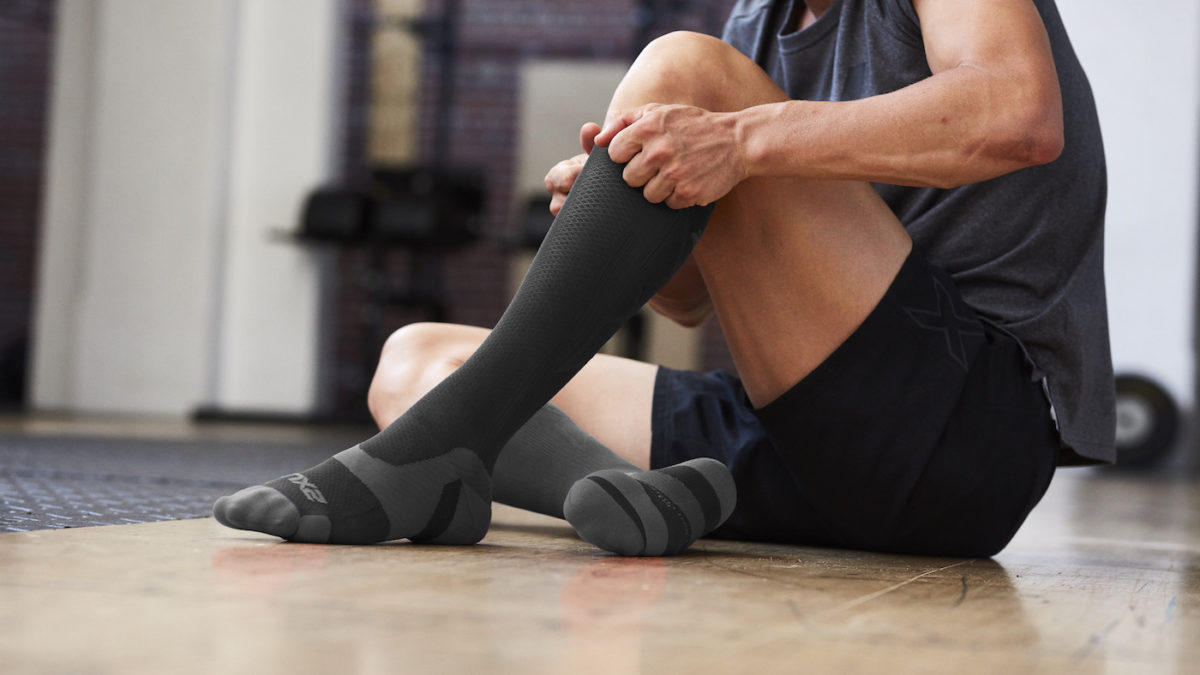Are you a runner looking to improve your performance? Discover how compression socks can be the secret weapon for your next race. With their snug fit, these specialized socks provide increased blood flow to your muscles, instantly boosting stamina and reducing fatigue.
Learn in our complete guide how compression socks can make you a better runner.
This Complete Guide on how Compression Socks can benefit Your Running Performance is designed to provide information on the benefits of compression socks as they relate to running. Compression socks are a valuable tool that can help runners improve their performance, prevent injuries, and reduce muscle fatigue. This guide will provide an overview of the benefits of compression socks, and explain why they can be a great choice for both avid runners and those just getting started.
Compression socks are designed to fit snugly around the feet, ankles, and calves to create a compressive force that encourages increased blood circulation throughout the lower legs. By improving circulation in the limbs, runners can reduce lactic acid buildup in their muscles which helps them run longer and reduce fatigue. In addition, by providing more support to the feet and ankles, compression socks can help prevent strain or injury from occurring during running activities.

closeup slender and beautiful legs of woman running in compression socks. fitness and exercise in forest
How Compression Socks work
Compression socks are specialized garments designed to improve blood circulation and reduce fatigue. As we mentioned earlier, when you put on a pair of compression socks, the material will apply pressure that squeezes your leg muscles, helping prevent blood from pooling in your legs. This increases blood flow to those areas, which can help reduce soreness and fatigue while you run.
Beyond that, the pressure created by compression socks can also help you run faster and farther by giving your body an extra boost of energy in the midst of running. As a result, many endurance athletes use compression socks as part of their training regimen to improve their race performance and encourage muscle healing post-run.
Finally, the snug fit of compression socks can also help support the arch in your foot—something that’s especially important for runners who struggle with plantar fasciitis or other arch-related running injuries—and alleviate swelling in your ankles.
Definition of Compression Socks
Compression socks, or compression stockings, are specialized garments worn around the lower legs that offer a compressive effect on the feet and ankles. They are designed to reduce muscle fatigue and strain, improve circulation, prevent muscle cramps and aches, reduce swelling in the legs and support weak muscles. Compression socks come in a variety of sizes, styles and colors to fit individual needs depending on activity level or health concerns.
Compression socks apply graduated pressure throughout the calf and foot with higher pressure near the ankle. The increased pressure helps promote better blood flow through your leg muscles by providing greater elasticity to your veins so they can move blood back up your leg with ease. This increases oxygen-rich blood flow to sore muscles, promoting quicker recovery times after strenuous activities such as running or exercise. In addition, compression stockings may also provide relief for uncomfortable edema (fluid retention) experienced during pregnancy or at high altitudes (altitude sickness).
Mechanism of action
When worn during running, compression socks apply pressure to the calf muscles and tendon fibres, increasing the amount of venous return needed for a healthy circulation. The effects of this include: reduced fluid buildup in the calf area, improved muscle oxygenation and post-exercise recovery time, improved lymph transport (removing toxins + metabolic waste from the muscles), and possibly reduced risk of muscle strain or damage.
Compression socks also tend to give the feeling of an extra spring in the stride meaning a more efficient biomechanical pattern in running mechanics. The joint abduction/adduction angles for mid-stance are known to be improved with compression wear which can result in greater energy efficiency during long distance running as well as reducing fatigue throughout training sessions.
Finally, thermal protection can also be provided by wearing compression socks as they help maintain muscle temperature during cold weather runs.
Benefits of Compression Socks
The many benefits of wearing compression socks when running are numerous. Not only do they reduce fatigue and improve circulation, but they can also help lower the risk of injury. Here are some of the most common benefits associated with compression socks:
– Enhanced blood circulation: Compression socks can help improve circulation and reduce muscle swelling during strenuous running sessions. This helps to reduce discomfort, fatigue, and even some types of pain that can be brought on by long runs.
– Reduced shin splints, plantar fasciitis, calf cramps: Compression socks offer support to the feet and ankles while running, helping to stabilize the ankle joint and keep your foot in place while you’re pounding the pavement. This helps to prevent injuries such as shin splints, plantar fasciitis, and calf cramps that often result from excessive padding or rigid support in traditional athletic socks.
– Decreased lactic acid buildup: A common cause of muscle fatigue during lengthy runs is lactic acid build up in our muscles. By wearing a pair of compression socks while you run, your feet remain compressed which increases blood flow to your legs and muscles—allowing them to have better oxygenation which reduces lactic acid buildup. With improved oxygenation comes increased endurance, so you may notice yourself being able to run longer distances with less effort than before!
– Increased comfort: Compression sock fabrics are created to keep your feet dry and reduce friction against the skin that can be caused by traditional cotton or wool materials often found in athletics socks. Additionally, many runners feel an enhanced ‘springy’ sensation when wearing compression apparel that adds expression during your run due its supportive structure on key areas such as ankles and calves.
Benefits of Compression Socks for Running Performance
Compression socks are designed to help improve running performance by providing extra support to your feet, calf muscles and other muscles you use while running. Compression socks open up and forth, helping move the blood better throughout the body and reduce fatigue during longer runs. These special socks come in various forms of tightness, so finding the right amount of compression is key for runners.
Compression socks can also increase oxygen delivery to your muscles during a run, reducing overall fatigue and soreness afterward. Additionally, they can help with heat management which can be useful during hot summer months when more perspiration occurs – allowing for greater fun and lower risk of overheating or blisters.
Kitting up with a good pair of compressive running socks can also reduce muscle vibration when running at higher speeds or on different terrains such as hills or trails. This helps improve performance by decreasing injury risk from straining the same muscles in each stride repeatedly. Furthermore, compression running socks offer additional protection from debris encountered on outdoor roads or trails by creating a barrier against metal objects like broken glass or rocks that could potentially enter shoes if not for compression sock’s extra shielding as an added layer between shoes and skin.
Improved Circulation
Using compression socks can help to improve circulation, particularly in the legs. Compression socks or stockings use elastic fabrics to create a snug fit around the foot and leg that supports blood flow back towards the heart. This increased circulation helps to reduce swelling and discomfort in the legs and feet, improving overall breathing and comfort while running.
Aside from improved circulation, compression socks also reduce muscle soreness after exercise, allowing for a more comfortable recovery period with decreased symptoms. Compression socks also help to keep your feet dry while running by pulling sweat away from your skin and releasing it through evaporation. As a result, your feet will stay dry during workouts and you’ll be less likely to develop any skin conditions such as athlete’s foot or blisters.
Lastly, because they give extra support to your ankles during activities like running or jogging, compression socks can reduce your risk of ankle strains and other injuries caused by overworked muscles in the ankles.
Reduced Muscle Fatigue and Soreness
Compression socks are designed to reduce muscle fatigue and soreness. This reduces your risk of injury and can help improve sport performance. The main mechanism behind this benefit is an increase in blood flow that occurs as a result of the compressive fit of the socks. Improved circulation allows for more oxygenated blood to reach muscles, which helps them remain strong during intense activity.
The increased support offered by the garment also helps to protect connective tissue from micro-trauma that can occur with repetitive muscle contractions. These benefits can be particularly beneficial for those engaging in long-distance running or other strenuous physical activities, helping athletes stay on their feet longer without feeling fatigued so they can perform better and safer throughout any workout or competition.
Increased Oxygenation
The increased pressure generated by compression socks helps to maintain your veins in an open state, allowing increased oxygen flow throughout your body. This is particularly beneficial during exercise when your muscles require more oxygen than usual.
Improved blood circulation and oxygen flow can help improve performance during running and other forms of exercise, as more oxygen and nutrients can reach the muscles they will be able to contract with more strength. Additionally, the improved removal of metabolic waste created by muscle contraction allows for quicker recovery time.
Compression socks have been found to be highly effective in athletes suffering from compartment syndrome as well as those athletes just looking for a performance edge.
Better Recovery Time
Compression socks used during running help to reduce recovery times both post-run and in the days afterward. When worn during training, these socks improve blood circulation, which helps to speed up the process of clearing lactic acid from the tissues in the lower leg. This can also reduce muscle soreness after a run and help you feel ready to perform again more quickly.
Additionally, compression gear is thought to provide improved stability when it comes to tendons and joints in the lower body, helping guard against potential injuries.
Protection from Injuries
When running, it is crucial to protect your feet and legs from fatigue, stress and overuse to reduce the risk of injuries. Compression socks help to prevent such injuries by providing snug, consistent pressure across the foot and calf muscles which can help to improve blood circulation and prevent muscle cramps.
Compression socks also act as armor for your feet and legs by absorbing low-level shocks generated during intense physical activity. This helps limit minor aches and pains that can become major problems over time if ignored. Compression socks further reduce the risk of injury by keeping your feet warm in cooler temperatures and wicking away moisture for a more comfortable run.
By simply wearing compression socks before running or working out, you can enjoy increased comfort and protection from minor injuries that could lead to more serious strains, sprains or ligament tears later on. Wearing compression socks during an activity can also keep you performing at higher levels longer without having to worry about potential injury risks or uncomfortable aches or pains.
Conclusion
In conclusion, using compression socks while running can provide a wide range of benefits, from greater comfort and stability during your runs to improved performance, reduced risk of injury, and better blood flow. As with any other type of running or exercise gear, it’s important to choose the right fit, style, and compression level for your individual needs in order to get the best results.
Be sure to consult with a qualified specialist if you have any doubts about what type of compression products are best for you. With the proper fit and care, compression socks can be an invaluable asset for any runner looking for improved performance and better recovery times.
FAQ’s
When should you run in compression socks?
Compression socks can be worn during running for various reasons such as improving circulation, reducing muscle soreness, and preventing injuries.
Why do you need compression for running?
Compression socks can help improve blood flow, reduce muscle vibration, and provide support to the muscles, which can lead to improved performance and decreased risk of injury.
Should you run long distance in compression socks?
It is safe to run long distances in compression socks if you have worn them before and they are comfortable for you. However, it is recommended to gradually increase the distance you run in compression socks.
Do compression socks help athletic performance?
Compression socks can help improve athletic performance by increasing blood flow, reducing muscle fatigue, and improving muscle recovery after exercise.
Do compression socks make you run faster?
Compression socks may not directly make you run faster, but they can help improve your running performance by reducing muscle fatigue and improving circulation, which can lead to better endurance.
Can compression socks give you energy?
Compression socks may not directly give you energy, but they can help reduce muscle fatigue and soreness, which can help you feel less tired during and after exercise.
Do compression socks help prevent injuries?
Compression socks can help prevent injuries by reducing muscle vibration, providing support to the muscles, and improving blood flow, which can reduce the risk of muscle damage and other injuries.
Do compression socks work for everyone?
Compression socks may not work for everyone, as individual preferences and medical conditions may affect their effectiveness. It is recommended to consult with a healthcare provider before using compression socks.
Can anyone benefit from compression socks?
Compression socks can benefit anyone who experiences muscle fatigue, soreness, or swelling, including athletes, travelers, and individuals with medical conditions such as varicose veins or lymphedema.
How long can you wear compression socks?
Compression socks can be worn for several hours at a time, but it is recommended to take breaks and remove them periodically throughout the day to allow for skin and muscle recovery. The exact length of time may vary depending on individual needs and preferences.
See Also-
- Best running shoes under $50
- Best nike running shoes for flat feet
- Best running shoes for treadmill
- Best pre workout for running
- Best running shoes under 100


